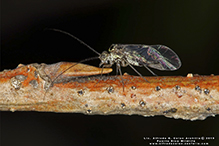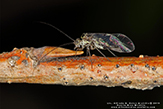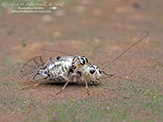Minnesota Barklice, Booklice,
and Parasitic Lice
Psocodea is the order insects that includes barklice, booklice, and parasitic lice. Until recently, barklice and booklice were placed in the order Psocoptera, and parasitic lice were were separated into the orders Mallophaga (chewing lice) and Anoplura (sucking lice).
There are about 11,000 species in more than 400 genera in 7 suborders of Psocodea worldwide. There are about 1,200 species in 3 suborders in about 200 genera in 43 families in North America north of Mexico. Only 15 species have been collected at Cedar Creek Ecosystem Science Reserve in Anoka, Minnesota. The total number of species in Minnesota is probably closer to 60.
Psocodea are small, soft-bodied, scavanging insects distinguished by the following:
- small, rarely more than 3⁄16″ (5 mm) long;
- large heads and bulbous bodies;
- mouthparts optimized for chewing;
- the central lobe of the lower mouthparts (maxillae) are rod-like and are used for stability while feeding;
- swollen forehead;
- long, thread-like antennae, with 13 to 50 segments, that are swept backward;
- huge compound eyes; most with three simple eyes (ocelli), some with none
- last part of the leg (tarsus) has 2 of 3 segments.
Many are wingless. Winged species
- have four membranous wings;
- wings are held roof-like and steeply angled over the body when at rest;
- the forewing is larger than the hindwing; and
- wing veination is reduced.

Recent Additions

There are just two North American species of Hyalopsocus. Only one, Hyalopsocus striatus, has been recorded in Minnesota.
Hyalopsocus striatus is a small insect but a medium to large sized common barklouse. It occurs mostly in the northeastern United States and southeastern Canada. There are spotty records in the western United States, and only a few records in Minnesota. It is probably underreported, being overlooked due to its small size, and being difficult to distinguish from many similar species for the same reason.
Hyalopsocus striatus is found on the trunks and branches of both hardwood trees and pine trees, on the shady sides of wood buildings, and on shaded wood piles.
Adults have a soft body, long wings, and a relatively large head. The species is identified by the pattern of brown markings on the forewing.
Other Recent Additions
This list includes only bark lice, book lice, and parasitic lice that have been recorded in Minnesota, but not all of the bark lice, book lice, and parasitic lice found in Minnesota.
| Profile | Photo | Video | |||
|---|---|---|---|---|---|
|
|
|||||
common barklouse (Psocus leidyi) |
|||||
common barklouse (Trichadenotecnum majus) |
|||||
fateful barklouse (Lachesilla andra) |
|||||
fateful barklouse (Lachesilla nubilis) |
|||||
hairy-winged barklouse (Polypsocus corruptus) |
|||||
lizard barklouse (Valenzuela pinicola) |
|||||
reticulate-winged trogiid (Lepinotus reticulatus) |
|||||
speckled barklouse (Metylophorus novaescotiae) |
|||||
Cerastipsocus venosus (tree cattle)
Hyalopsocus striatus (common barklouse)
Lachesilla andra (fateful barklouse)
Lachesilla nubilis (fateful barklouse)
Lepinotus reticulatus (reticulate-winged trogiid)
Metylophorus novaescotiae (speckled barklouse)
Metylophorus purus (common barklouse)
Polypsocus corruptus (hairy-winged barklouse)
Psocus leidyi (common barklouse)
Trichadenotecnum majus (common barklouse)
Valenzuela pinicola (lizard barklouse)
No Species Page Yet?
If you do not see a linked page for a species in the list at left you can still upload a photo or video or report a sighting for that species. Click on one of the buttons below and type in the common name and/or scientific name of the species in your photo, video, or sighting. A new page will be created for that species featuring your contribution.
These buttons not working for you?
Simply email us at info@MinnesotaSeasons.com.



